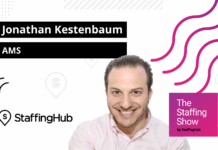
Written by Adam Day, President & CEO at Timerack
In the business of staffing, trust and transparency are non-negotiable. This means that staffing agencies must have impeccable communication skills to communicate effectively with their clients, creating a solid foundation to build relationships upon. However, communication mishaps and reporting errors will still occur for even the most well-managed of staffing agencies, potentially alienating clients.
When mistakes do occur, accountability is a must. It’s crucial for staffing agencies to focus on strengthening their lines of communication and reporting procedures with clients, ensuring they don’t lose faith over innocuous mistakes.
Luckily, technology is here to reduce human error and facilitate more effective communication. By automating otherwise painstaking processes, staffing industry experts can spend more time focused on tasks that require a human touch.
Of course, technology is not a substitute for doing the groundwork, i.e., building interpersonal relationships. But tech can lighten the load and free up time to dedicate to clients more directly.
Strengthen communication
Effective communication is the foundation of healthy client relationships, so it’s best to use external systems to smoothly facilitate client interactions. This can look like everything from establishing direct lines of communication online to using software to provide automatic updates and progress indicators to clients.
For one, digital platforms can smoothly facilitate communication between agencies and clients—be it Slack, Google Hangouts, or Microsoft Teams. These platforms allow a constant line of communication; the client can reach an industry expert whenever, wherever.
What’s more, digital platforms and software can manage workflow and keep everyone in the loop. There are a variety of web-based services out there for task tracking, like ClickUp, Smartsheet, and Monday.com, all of which let both the agency and the client view current progress and project updates. So, when you speak to a client directly, they are already up-to-date on the current project status. This allows you to have more in-depth and efficient conversations about their needs, instead of spending an entire call playing catch-up.
Produce better reports
When talking about better reporting standards, most people assume this means issuing more reports, more frequently. On the contrary, staffing agencies often needlessly inundate their clients with data. Agencies need to produce more meaningful data, but not necessarily more. Better reporting processes will put you and your client on the same page, ensuring no one feels out of the loop.
Instead of issuing informative reports with clear data points of interest, agencies will often share massive data files that fail to highlight the key results. This leaves clients looking for a needle in a haystack, so to speak.
To provide clients with informative data points and insightful reports, look for data analytic tools to produce concise explanatory reports, complete with graphs and clear progress indicators. You and your clients can determine the metrics that are most meaningful to you, but examples might include monitoring employee productivity, average time to fill vacancies, the client’s return on investment, etc.
Ensure accuracy
One of the biggest points of contention in client-agency relationships is human error. Innocuous computing mistakes and incorrect invoices can cause clients to quickly become disillusioned with your services. So, you absolutely don’t want to be billing them incorrectly.
Unfortunately, accounting errors are largely on the rise. This is primarily a result of the current labor shortage, with staffing agencies now assigning a single worker to two, three, or even four assignments within the same company. Assignments often have different pay grades, which can lead to administrative nightmares.
By automating time and attendance reporting, you can avoid these pains entirely. You can reduce human error, ensure accuracy, and automate the entire payroll process, from having employees clock in and out to computing their pay.
After employees log their hours digitally, whether it’s on a smart kiosk or mobile application, the services will then dispatch employee time and attendance data directly to a company’s existing payroll platform. This allows an agency to instantly automate payroll with little to no human input.
Optimize workflow
Staffing agencies must practice excellent task management and learn to juggle multiple assignments at once. Luckily, workflow automation software can optimize internal workflow and task management.
Workflow automation tech is intended to streamline processes and analyze individual employee output to determine how collaboration can best be achieved: identifying areas where employees may be performing the same duties on top of one another, versus gaps in the workflow, i.e., duties that no one is doing.
Workflow software can do everything from generating invoices to scanning emails with colleagues and automatically creating to-do lists based on tasks that have been assigned.
The best workflow tech can also aid in developing inter-departmental collaboration to ensure everyone is in the know. For instance, human resources, IT, and finance must have clear lines of communication and working relationships with each other to ensure all relevant information is passed between departments in a timely manner.
Otherwise, a computing error that arises in one agency branch can have serious implications for other departments, potentially creating system-wide havoc. Siloed departments will be unable to identify where the issue arose, or know the best course of action to resolve it: but not so when all tasks are managed in one place, in the same system, where everyone can track workflow.
When the left hand knows what the right hand is doing, this leads to more efficient staffing services, and more satisfied clients.
Personalized customer care
You want happier clients? Then provide them with more personalized, custom-tailored experiences. Greater customer contact and frequent interactions lead to a more satisfied clientele overall.
You must personally familiarize yourself with the client’s short and long-term goals, and then use the tech to make sure you’re hitting those aims on the mark.
Personalized staffing solutions can include predicting a client’s needs in advance, analyzing each client’s business and their work requirements, or even noting down a big day like a work anniversary, etc.
Once you have all of your insights gathered from your technology, you need to add the human element. You know what a client needs, their expectations, and the progress thus far. Now, you can make it personal.
 Written by Adam Day, President & CEO at Time Rack, that provides recruitment invoicing software integration, time and attendance tracking and HR services to medical and other types of staffing agencies.
Written by Adam Day, President & CEO at Time Rack, that provides recruitment invoicing software integration, time and attendance tracking and HR services to medical and other types of staffing agencies.






